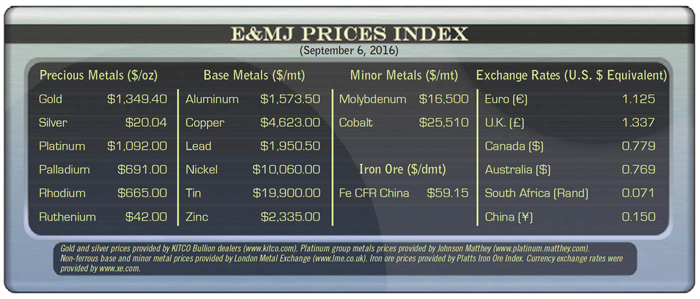Metal prices, except for tin, remained relatively flat during August. Tin prices on the E&MJ Price Index increased 11.5% to $19,900 per metric ton (mt) from $17,850/mt last month. Four smelters, accounting for 18% of China’s output, were temporarily closed after failing environmental inspections, which caused tin markets to tighten.

After a recent visit to Myanmar, the International Tin Research Institute’s (ITRI) China staff also reported that tin production in the region may have peaked at some 50,000 mt/y. Myanmar has seen a more than tenfold increase in tin production since 2011. This is almost entirely due to the rapid growth in a major new mining center in Wa county, close to the border with China’s Yunnan province. The main mining zone, called Man Maw, covers a 200-km2 area, 90 km northwest by road from Pangsang on the China-Myanmar border. Current mining activity is focused in a 20-km2 area and these operations now account for some 95% of estimated total national production. There is, however, still significant potential for the discovery of new ore resources, according to ITRI.
Wa county production can be measured by China’s official tin ore and concentrate import data. ITRI believes that the big increase in imports reported by China in the first half of 2016 (up 88% year-on-year in gross weight terms) is based on a depletion of above ground stocks of ore and concentrate accumulated over the last few years. This masks an underlying decline in mining activity and depletion of readily accessible higher grade ore resources, according to ITRI.
In 2014, ITRI reported that most production came from several large open-pit mines, but these have been largely depleted, and today most mining is underground, with higher operating costs and lower ore grades. Since then, many small mining companies have failed or left the area and the companies who are still involved are generally bigger, better organized and well financed. They have invested heavily in the mechanization of mining and have expanded ore processing facilities, along with transport and other infrastructure.
While grades of more than 10% were common two years ago in this region, most ore mined now grades between 2%-3% tin. In the short-term, output from Wa seems stable but production and shipments will be reduced in the rainy season, which continues until October. The longer-term outlook for production in Wa mainly depends on whether there are new resource discoveries in the next few years.







